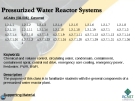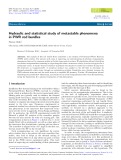
Pressurized water reactors
-
In BWR’s steam bubbles have a negative steam bubbles have a negative reactivity feedback, if the steam fraction reactivity feedback, if the steam fraction increases in the core the reactor power increases in the core the reactor power decreases
 34p
34p  tieunhan202
tieunhan202
 07-10-2013
07-10-2013
 58
58
 7
7
 Download
Download
-
State the mechanism for steam generation in a PWR. Using simplified diagrams, identify and explain the purpose of the major components and equipment involved with a PWR. Identify the equipment used to control reactor power.
 24p
24p  giotletinh_hd2009
giotletinh_hd2009
 14-10-2013
14-10-2013
 85
85
 8
8
 Download
Download
-
Design Philosophies: Radiological release to the environment is prevented by maintaining R/B pressure negative(-63Pa). Radioactive substance in PCV are removed and captured in the filter device.R/B Closed Cooling Water System (RCW) / Reactor Service Water System (RSW) How are the many Heat exchangers cooled down?
 33p
33p  giotletinh_hd2009
giotletinh_hd2009
 14-10-2013
14-10-2013
 88
88
 7
7
 Download
Download
-
The capability of eddy current testing (ECT) for the bottom mounted instrumentation (BMI) weld area of reactor vessel in a pressurized water reactor was demonstrated by the developed ECT system and procedure.
 8p
8p  christabelhuynh
christabelhuynh
 31-05-2020
31-05-2020
 19
19
 0
0
 Download
Download
-
This article discusses the evolution of the collective dose for several types of reactors, mainly based on publications from the NEA and the IAEA.
 8p
8p  christabelhuynh
christabelhuynh
 30-05-2020
30-05-2020
 21
21
 0
0
 Download
Download
-
This process periodically speeds up the corrosion of the zirconium cladding in the aqueous coolant due to the breakaway of the dense part of oxide scale when its thickness reaches 2 mkm. It is shown that the electronic resistivity of zirconia is not limiting the zirconium oxidation at working temperatures.
 5p
5p  christabelhuynh
christabelhuynh
 30-05-2020
30-05-2020
 12
12
 1
1
 Download
Download
-
The objective of this work is to experimentally investigate the effect of the oxygen potential on the fuel and FP chemical behaviour in conditions representative of a severe accident. More specifically, the speciation of Cs, Mo and Ba is investigated.
 10p
10p  christabelhuynh
christabelhuynh
 29-05-2020
29-05-2020
 11
11
 3
3
 Download
Download
-
The present work aims at improving our understanding of nefarious reorganisation phenomena observed by numerous studies in the flow large-scale structures. 3D simulations allowed identifying two distinct reorganisations consisting in a sign change for either a transverse velocity in rod-to-rod gaps or for a subchannel vortex.
 7p
7p  christabelhuynh
christabelhuynh
 29-05-2020
29-05-2020
 10
10
 0
0
 Download
Download


















